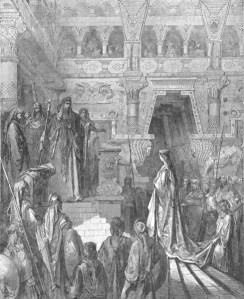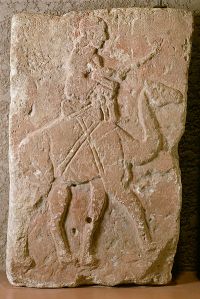And she gave the king one hundred and twenty talents of gold, spices in great abundance, and precious stones; there never were any spices such as those the queen of Sheba gave to King Solomon (2 Chron. 9:9).

Public domain http://www.wpclipart.com
When the queen departed Sheba, Scripture says she came to Jerusalem with “a very great retinue.” How many does “very great” indicate? No consulted commentary ventures any speculation, but perhaps there is a way to guesstimate. Bible scholar, Leon Wood, equates a talent (the queen gave Solomon one hundred and twenty talents of gold) to just over sixty-six pounds.[1] A rough calculation yields 7,920 pounds…of gold—worth a staggering amount by today’s precious metals market! Evidently a dromedary camel can carry from 300-900 pounds (per a Goggle search). That means the queen could have had anywhere from nine to twenty-six camels just to carry the gold.[2]
There is no way to determine the weight of the jewels or the spices so as to calculate how many additional camels were needed. Nor is there any way to assess how many attendants would have accompanied her, whether she was escorted by armed guards or units of her army perhaps, or how many of these pack animals were needed to carry necessities such as food, clothing and shelter (i.e., tents). Suffice it to say, “she came with a very great retinue” (1 Kings 10:2).
“. . .there never were any spices such as those the queen of Sheba gave to King Solomon . . . .”
Why were spices of such note in this account? Why would they have been gifts worthy of the king of Israel? There are several reasons, some going farther back into antiquity.
1. A primary consideration is one of commerce. According to a note in The Women’s Study Bible (p. 565), Sheba’s considerable economy was “dependent upon worldwide, overland spice trade.” Solomon’s new trade alliance with Hiram, king of Tyre, may have caused the queen concern since her merchants must travel through Israel in order to reach other distribution points. Her gifts, including an abundance of spices, were no doubt part of trade negotiations, and as such, were expected. 1 Kings 10:22-25 fills in some of the details.
Arabia was known for its dominance of the spice trade, and went to great lengths to guard its “trade” secrets. It was not above using disinformation as to the origin of its precious commodities (many of which came from as far away as India) nor the routes used to procure/transport them. By keeping a corner on the spice market, Arabia, and in this case, Sheba, could control the supply, charge exorbitant prices, and thus far, avoid paying duty. There was much at stake during this meeting of two formidable potentates.
2. Spices and aromatic gums were quite valuable—some of them were purportedly deemed more precious than gold—and in demand. As early as Genesis 2:12 bdellium,[3] a fragrant gum resin which is thought to be from the arid regions of western India, is mentioned. Another mention of spices is found in the Joseph narrative (Genesis 37:25). Joseph was cast into a pit by his jealous brothers, and eventually sold to a caravan of Ishmaelite (some say Midianite)[4] spice merchants traveling the main trade route from Gilead to Egypt—possibly one of the routes the queen intended to use.

Cinnamon bark (publicdomainpictures.net)
Though hundreds of years later than the time of Solomon, in the days of the early Roman empire, naturalist Pliny the Elder, in his Natural History, wrote that a pound of pepper, the cheapest and most available spice, would buy forty pounds of wheat, and “a pound of the finest cinnamon oil [which most likely came from India or modern-day Sri Lanka] would cost a centurion up to six years’ work.”[5]
3. Spices were used in funerary preparations—both as preservatives and agents to control the odors of putrefaction. Egypt in particular is known for its embalming techniques and funerary practices involving various herbs, unguents and spices.[6] Using these to slow or kill bacteria that caused decomposition was an effort to keep a corpse fresh and presentable. According to Egyptian belief, mummification preserved a home—a necessary physical frame—to which the immortal ka (life principle) could return.[7]
Israel had its own funerary practices. 2 Chronicles 16:13-14 recounts the burial of King Asa of Judah: “They buried him in his own tomb, which he had made for himself in the City of David; and they laid him in the bed which was filled with spices and various ingredients prepared in a mixture of ointments. They made a very great burning for him.”
4. Spices and unguents were used in religious rituals. In Leviticus 24:7 Moses is instructed to pour “pure frankincense” on the showbread. In Exodus 30:22-33 he is given the formula for holy anointing oil. Using quality spices, perfumers were to combine:
- five hundred shekels of liquid myrrh,
- half as much sweet-smelling cinnamon (two hundred and fifty shekels),
- two hundred and fifty shekels of sweet-smelling cane,
- five hundred shekels of cassia, according to the shekel of the sanctuary,
- and a hin of olive oil.
He was further instructed, ‘”With it you shall anoint the tabernacle of meeting and the ark of the Testimony; the table and all its utensils, the lampstand and its utensils, and the altar of incense; the altar of burnt offering with all its utensils, and the laver and its base. You shall consecrate them, that they may be most holy; whatever touches them must be holy. And you shall anoint Aaron and his sons, and consecrate them, that they may minister to Me as priests. And you shall speak to the children of Israel, saying: ‘This shall be a holy anointing oil to Me throughout your generations. It shall not be poured on man’s flesh; nor shall you make any other like it, according to its composition. It is holy, and it shall be holy to you. Whoever compounds any like it, or whoever puts any of it on an outsider, shall be cut off from his people.'”
Presumably Solomon himself was anointed king with this same holy oil (1 Kings 1:38-39). “The anointing of Solomon was carried out immediately, as the king had commanded. . . .‘The oil-horn out of the tent’ (i.e., a vessel made of horn and containing oil) was no doubt one which held the holy anointing oil, with which the priests and the vessels of the sanctuary were anointed (see Exo. 30:22 ff.).”[8]
Next time…
There is another reason Solomon would have welcomed such an abundance of spices, one which has to do with his harem. We’ll explore this fascinating topic in the next post.
[1] Leon Wood, A Survey of Israel’s History (1970), p. 292, note 16. However, The Expositor’s Bible Commentary, Vol. 4, 1, 2 Kings, v. 10, equates the 120 talents to be four and one-half tons (p.101)! The above calculation would have to be refigured based on this formula.
[2] There is an ongoing mystery as to the source of the queen of Sheba’s gold. As recently as February 2013 a British archaeologist discovered what may have been her gold mine in northern Ethiopia. Historically Ethiopia was part of the territory of Sheba according to some scholars, and thus under the queen’s control.
[3] F. Rosengarten, Jr. 1969. The Book of Spices, pp. 23–96, Jove Publ., Inc., New York. http://www.hort.purdue.edu/newcrop/Hort_306/reading/Reading%2026-1.pdf
[4] It seems ironic that these merchantmen could have been distant relatives of Joseph’s through Keturah, Abraham’s wife after Sarah died. See Genesis 25:1-2.
[5] Jack Turner, Spice: The History of a Temptation (2004), p. 73.
[6] In the winter of 1975-1976 the deteriorating mummy of Ramses II (argued by some to be the pharaoh of the exodus) was sent to the Musee de l’Homme in Paris for conservation concerns. An x-ray revealed for the first time that peppercorns had been inserted into the king’s nose with plugs of an unidentified resinous substance. Jack Turner, in his book, Spice: The History of a Temptation, mentions, “. . . its [the peppercorn] identity confirmed after an exhaustive process of elimination of native African species some three millennia after its harvest somewhere in the tropical south of India” (p.146).
[7] Turner, p. 147.
[8] From Keil and Delitzsch Commentary on the Old Testament: New Updated Edition, Electronic Database.


 The levirate law played a part in Boaz’s ancestry, going back six generations to Perez, one of the twin sons of Tamar (Matt. 1:3). Tamar (possibly a Canaanite woman) was married to Er, the firstborn son of Judah. Er died because of an unspecified wickedness that angered God, and Tamar was left a childless widow. In accordance with the levirate law, Judah told Onan, his second son, to impregnate Tamar and preserve the family line of his deceased brother. But Onan refused to beget children for Er. His callous disdain for Tamar displeased God. Onan died for his contempt of duty, and Tamar was widowed the second time.
The levirate law played a part in Boaz’s ancestry, going back six generations to Perez, one of the twin sons of Tamar (Matt. 1:3). Tamar (possibly a Canaanite woman) was married to Er, the firstborn son of Judah. Er died because of an unspecified wickedness that angered God, and Tamar was left a childless widow. In accordance with the levirate law, Judah told Onan, his second son, to impregnate Tamar and preserve the family line of his deceased brother. But Onan refused to beget children for Er. His callous disdain for Tamar displeased God. Onan died for his contempt of duty, and Tamar was widowed the second time.